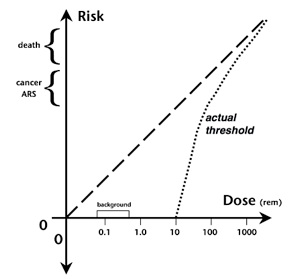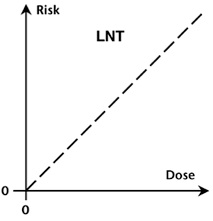The LNT — Linear no-threshhold hypothesis of radiation damage
The currently ruling idea about harm to humans from long-term exposure to radiation is that there is no lower limit to the effects of radiation in causing cancer. It is the operative theory at the U.S. Environmental Protection Agency and governs all rules about managing nuclear facilities, waste, etc. The rest of the world has followed the U.S. lead in this matter.
There is growing evidence that the LNT theory is profoundly wrong.
There were worries about it back in 1960 when the U.S. government first gave it regulatory force. President Eisenhower’s science advisor, George Kistiakowsky, noted in his diary for May 13, 1960, that when the matter came under review by the Federal Radiation Council:
“The discussion was rather heated and I said some uncomplimentary things about making math into a fetish without understanding it. At issue was the reference to a linear relation between dose and effect, which I still believe is entirely unnecessary for the definition of the current radiation guidelines, since they are pulled out of thin air without any knowledge on which to base them.” (p 326 in A Scientist at the Whitehouse, Harvard, 1976)
The LNT is an extrapolation from research on cancer among survivors of Hiroshima. There appeared to be a linear relation between radiation exposure and incidence of cancer—less exposure, less occurrence of cancer. The effects of very low doses of radiation could not be measured, so the assumption was made that any extra radiation led to some extra cancer, all the way down to zero radiation.
Here I will draw on some slides used by geologist Jim Conca, CEO of the Carlsbad Environmental Monitoring and Research Center, which monitors the WIPP nuclear repository. The LNT looks like this:
This is the LNT with Conca’s notes about the origins of the theory in Hiroshima bomb survivor cancer statistics. The chart shows that acute exposure to more than 100 rem (100,000 millirem) causes death, and exposure to between 100 and 10 rem (10,000 mrem) causes acute radiation syndrome (ARS) and some cancer—more above 200 rem than above 100 rem. But below 10 rem, no long term health effects have been observed in Hiroshima survivors or elsewhere. They are surmised by the LNT but have not been detected.
Conca suspects that there is a significant difference between sudden, acute exposure to high-dose radiation and long-duration, chronic exposure to low doses. He suggests that “Small chronic doses of radiation, less than 10 rem/year, appear to be easily handled by cellular repair mechanisms that evolved with the eukaryotic cell 2.3 billion years ago—a normal adaptive response.” Accordingly, he expects that a threshold will be found around 10 rem/year (10,000 mrem/year), below which chronic low-dose exposure will be found to be non-harmful.
If the ultra-low-dose radiation research proceeding at the WIPP proves that such a threshold exists, then the world changes if the findings are confirmed and the Environmental Protection Agency changes its requirements, then the costs of managing nuclear reactor sites, nuclear fuel shipping, and waste handling drop dramatically. Once the public absorbs the news, then the panic effects following radiation release incidents would also drop dramatically. The residents of the Chernobyl area could cheer up and stop feeling like victims, for a start.


